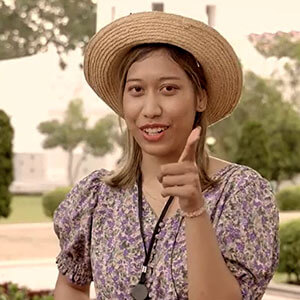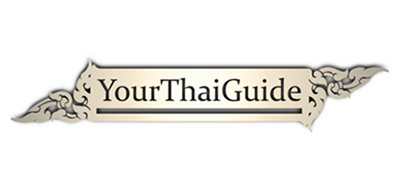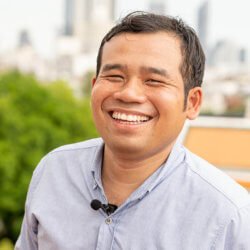Wat Bowonniwet Vihara is the main temple complex situated on the northeast side of Bangkok’s Rattanakosin island, just inside the old city wall bordering Banglumpoo canal. The name literally translates as the ‘Excellent Abode Monastery’, but the meaning behind the name is ‘Temple where the Viceroy Resides’.
Wat Bowonniwet Vihara has a long and interesting history, rich with symbolism intertwined with Thai royalty. The temple, also known as Wat Bovornives was built during the reign of King Nangklao (Rama III) in the first half of the 19th century, when it was called Wat Mai. Originally there were two temples separated by a canal, Wat Rangsi Sutthawat and Wat Mai. The two temples were merged into the Wat Bowonniwet in 1923.
The Temple Precincts
Buddhist monasteries are typically divided into two sections: Buddhavasa (sanctuary), buildings and structures devoted to the Buddha, such as the Uposatha hall, the Cetiya or Stupa, and Sanghavasa, containing residential dwellings for monks (bhikkhus) and novices (samaneras).

Structures of the Wat Bowonniwet
Chedi
The 50-meter high golden chedi is the most important structure of the temple, since it enshrines sacred relics. The chedi sits on an elevated base with a lower and upper terrace. The lower terrace contains depictions of celestial beings from Hindu mythology. At each of the corners of the terrace is a small prang (Khmer style tower) enshrining an image of the Buddha in the Abhaya (dispelling fear) mudra.
The hollow chedi is closed to the public, except on Wat Khao Phansa day, usually in July. Inside are five small golden chedis that contain sacred relics.
Scripture library
Near the chedi is the temple’s scripture library, the Ho Trai. Ancient boxes store the Tripitaka, the ancient Buddhist texts written on dried palm leaf. The Ho Trai’s walls are adorned with murals.
Ubosot
The ubosot (bot for short) or ordination hall was built during the reign of King Rama III. It is considered the holiest of rooms in the complex and is where ordinations take place. The entrance door is richly decorated with gilded carvings. Murals from the second half of the 19th century depict stories from the Buddhist teachings. The murals on the bot’s interior walls were traditionally light and limited in subject matter and style and were painted to appear three-dimensional. Monk artist Khrua In Khong introduced western style into the murals which depict Buddhist subjects.
The T-shaped bot holds a magnificent Sukhothai-period Buddha, cast in 1257 CE to celebrate freedom from the Khmers. In fact, the bot enshrines two large golden Buddha images. It is rated as a must visit as the statues are so big and impressive.

Viharn Geng and Viharn Phra Sasada
The Viharns, also known as Sermon Halls, can sometimes be busy places within temple grounds. The Viharn Geng features images of the Buddha. The base of one contains some of the ashes of King Mongkut. The Viharn Phra Sasada has two rooms, the front room contains the Phra Sasada Buddha image, after which the Viharn was named, in front of it is an ancient Mon Dvaravati era stone Buddha image. The second room features a reclining Buddha image called Phra Saiya.
Bodhigara – Bodhi tree building
The Bodhigara is a structure built to protect a Bodhi tree. The original tree is believed to be an offspring of the tree under which the Buddha reached enlightenment 2,500 years ago. This original Bodhi tree was planted in the temple grounds by King Mongkut. The original Bodhi tree did not survive so King Bhumibol planted another tree, another offspring of the Bodhi tree in India.

Phra Tamnak residences
The grounds of Wat Bowonniwet contain several Phra Tamnak buildings. They are residences for royalty or high-ranking Buddhist monks.
How to get to the Wat Bowonniwet
The temple is located on Phra Sumen road in Bangkok’s Phra Nakhon district.
The easiest and most comfortable way to get there is by taxi. The ride from the Grand Palace should cost between 50 and 100 Baht. The nearest Chao Phraya river boat pier is Phra Athit pier which is about 700 meters away.
Other temples to visit nearby include:
Make a visit to Wat Bowonniwet Vihara part of your tour itinerary. Khao San Road and Soi Rambuttri are close by and both are both great places to indulge and refresh yourself to get ready for the next exciting chapter of your Bangkok experience. Just ask your tour guide and they’ll put it all together for you so all you have to do is enjoy your time in Bangkok!
Wat Bowonniwet Vihara can be visited every day of the week from 6am until 6pm. The Ordination Hall is only open for morning prayers from 8am until 8:40am and again for evening prayers from 8pm until 9pm.
Admission Price: Free entry.
Things you should be aware of when visiting Wat Bowonniwet Vihara:
- Respectful attire is required. Wat Bowonniwet Vihara is a functioning Thai Buddhist temple, and as such the management insists that visitors dress in a respectful manner. This means that men must wear long pants and short-sleeved or long-sleeved shirts (no tank tops or sleeveless shirts). Women must wear skirts or pants extending at least to the knee, and also should not wear a top that reveals bare shoulders.
- Visitors are allowed to take photographs in any area of the complex.
- The Wat Bowonniwet Vihara is an important Royal temple, so please dress appropriately (no revealing clothes). Also remember to behave appropriately, be quiet, and be respectful as many locals attend to pray and worship.








